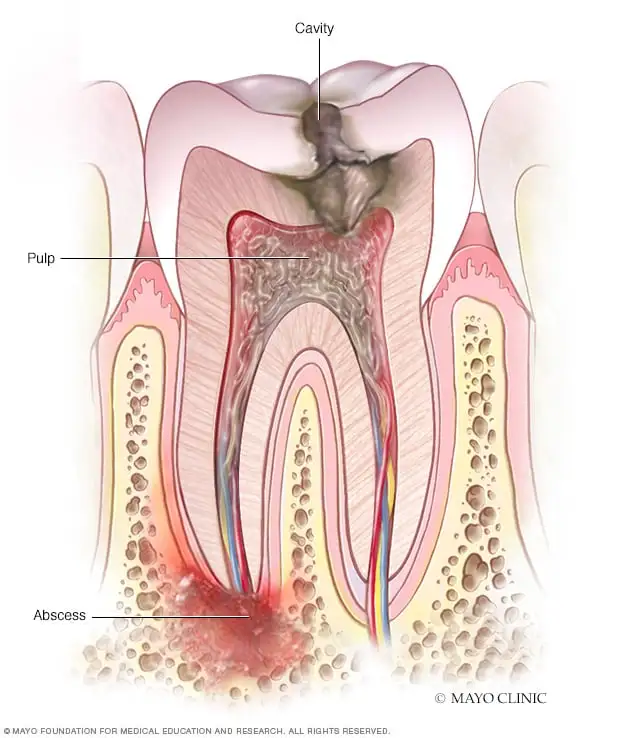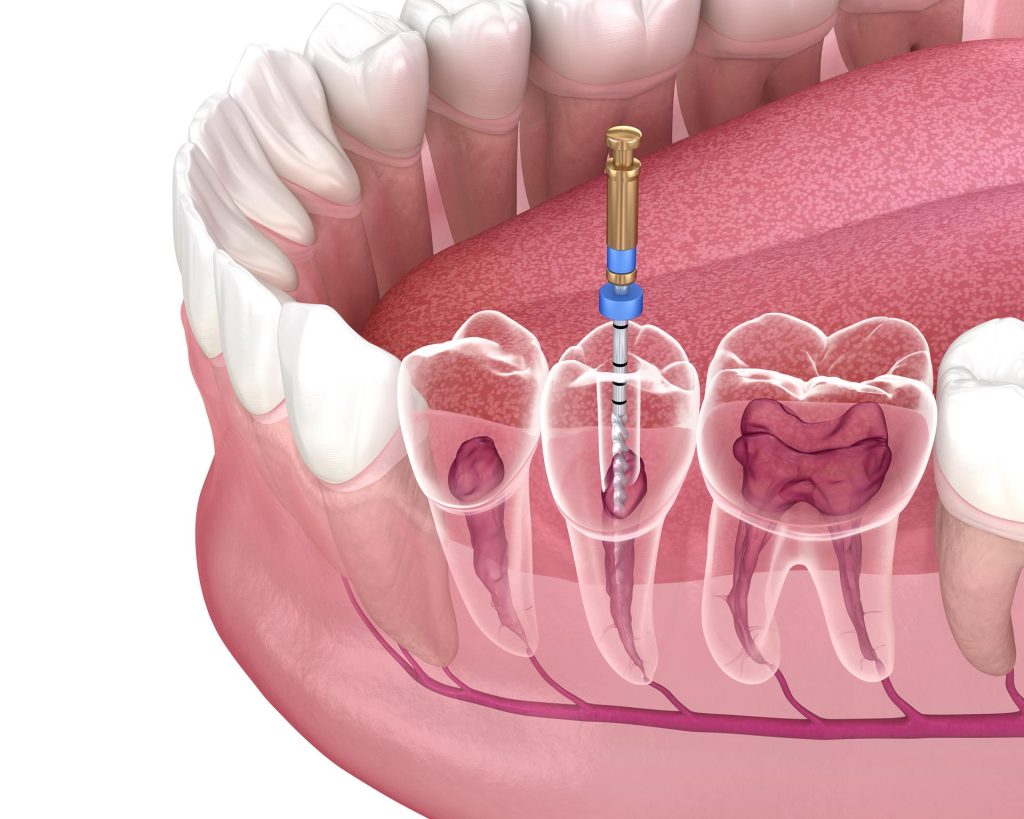Last Updated on: 4th December 2024, 05:17 pm
What are the symptoms of a spreading tooth infection?
It is very common for dentists, general practitioners, and in emergency cases to treat patients with symptoms of a tooth infection spreading due to possible dental problems; however, most professionals in the usual consultations do not have much information.

It should be explained that acute infections occur when bacteria penetrate the dental pulp (nerve); if not controlled, they can spread to other tissues, such as blood vessels, bones, and other areas of the oral cavity.
In addition to being a localized disease, dental infections can spread regionally and hematogenously, leading to serious infections, especially in medically-compromised patients. The purpose of this article is to guide to encourage people to act promptly.
What is a dental abscess or infection?
Remember that a tooth is made up of dentin, enamel, and a root. Inside is a soft fibrous tissue called the dental pulp. When an acute dental abscess occurs, it means bacteria have entered the pulp due to the accumulation of pus. It indicates that an infection is present in the tooth as a result of poor oral hygiene or a broken or fissured tooth.

A dental infection can be located in different regions. If it occurs at the tip of the root, it is called a periapical abscess; if in the gums or on the sides of the tooth root, it is deemed a periodontal abscess.
An important factor in the development of dental infections throughout the world is the lack of access to dental treatment since in many countries, it entails a very high cost.
Symptoms of a dental infection
- Some symptoms of a dental infection:
- Pain: a throbbing sensation in the tooth and intense, stabbing, and persistent pain that radiates to the neck, ear, and jaw. It becomes worse when lying down.
- Sensitivity: the patient feels discomfort when chewing, squeezing the teeth, and with hot or cold foods.
- Gum injury: swelling in the gingival area near the tooth. It takes on the appearance of a pimple that drains pus. Bursting may lessen the pain, but it does not mean that the infection is gone.
- Swelling in the area: increased volume in the face, cheeks, or the vicinity of the affected part.
- Swollen lymph nodes: nodes in the jaw and neck are swollen and tender to the touch.
- Fever
- Bad breath and an unpleasant taste in the mouth.
- Difficulty swallowing or breathing
What happens when a dental infection spreads?
When a dental abscess occurs, and proper treatment is not indicated or followed, the infection will likely spread to other areas of the body, causing serious and even life-threatening complications. It is not common for infections to spread, but in some regions due to poor access to basic services such as water, health, and food, they are likely to occur.
Possible complications::
- Osteomyelitis: an infection of the bone surrounding the tooth.
- Cavernous sinus thrombosis: an infection of the blood vessels in the sinuses.
- Cellulitis: an infection of the skin and the fat directly under it
- Parapharyngeal abscess: an abscess in the back of the mouth.
- Sepsis: a serious medical condition in which the immune system overreacts to an infection in the blood.
- Brain abscess (a rare and life-threatening infection)
- Endocarditis: the infection travels to the heart through contaminated blood vessels.
- Bacterial meningitis: infected blood vessels and nerves carry the infection to the brain.
- In some cases, these infections can become systemic, affecting multiple tissues and systems throughout the body.
Symptoms of a tooth infection spreading

Symptoms of a tooth infection spreading to the body include:
- Fever
- Headache
- Dizziness
- Fatigue
- Redness of the skin
- Sweating/chills
- Swelling of the face, making it difficult to open the mouth, swallow, and breathe properly
- Severe and painful swelling of the gums
- Dehydration leads to darker urine and less frequent urination
- Increased heart rate
- Increased respiratory rate (greater than 25 breaths per minute)
- Increased body temperature
- Stomach pain, diarrhea, and/or vomiting
Note: Severe pain and flu-like symptoms are common signs of spreading.
Dental abscesses can lead to brain abscesses (in rare cases). This is why you should never leave them untreated. Vision changes and weakness of the body on one side are common with them. Symptoms of a brain abscess due to a spread dental infection:
- Fever
- Headache
- Chills
- Visual changes
- Body weakness on one side
- Seizures
- Nausea
- Vomiting
- Personality changes
- Going in and out of consciousness
How might the infection or abscess be treated?
Before diagnosing and starting treatment, your dentist will perform certain diagnostic tests to properly guide infection management. Some examples of diagnostic tests are X-rays, computed tomography, inspection at the site of infection, and/or thermal tests to identify the sensitivity of the gums.
It is important to clarify that the infection will not go away on its own. Here are basic treatment strategies:
1. Root canal treatment or endodontics

This helps eliminate the infection and save the tooth if it has not yet reached the bone. The infected pulp of the tooth is removed, and the space is filled. The tooth is not lost, usually in mature teeth. After this, in a few days, it should return to normal, and the treated tooth could last a lifetime.
2. Incision and drainage
Your dentist will make a small incision (cut) in the abscess to drain the pus. Sometimes, a small rubber band is placed to keep the incision open and draining. If you have the right equipment, perhaps you can try to drain the tooth abscess at home with the help of our guide.
3. Tooth Extraction

Sometimes, the tooth cannot be saved, so your dentist will remove it and all tissue affected by the infection.
4. Medicines
On some occasions, when the infection is not advanced, management with antibiotics is possible; however, if there is already an abscess, your dentist will likely opt for another treatment but indicate antibiotic treatment as a long-term strategy to eliminate the infection and prevent it from spreading. Depending upon how advanced it is and what type of bacteria is involved, it will require management with different antibiotics, or in more severe cases, it will be done in a hospital intravenously. But if think you can handle things at home, perhaps you can try some of our recommendations of the most effective natural antibiotics for tooth infections.

To prevent the annoying and potentially dangerous symptoms of a dental infection, certain good habits should be practiced regularly since correct oral hygiene is the key to a healthy mouth. Frequent brushing and flossing are necessary to prevent cavities which, if left untreated, can lead to infections. The use of fluoride and a balanced diet with little to no sugar content will also prevent this dental disease.
Contact us
If you have any questions about this or other topics, you can contact us at Channel Island Family Dental as well as our Facebook page. We look forward to your visit, and we will make a timely diagnosis. Our dentists in Oxnard, Saint Paula, Ventura, Newbury Park, and Port Hueneme will be able to guide you toward the best treatment to take care of your health and give you back your best smile.
Bibliography
- Robertson DP, Keys W, Rautemaa-Richardson R, Burns R, Smith A J. Management of severe acute dental infections BMJ 2015; 350:h1300 doi:10.1136/bmj.h1300. (accessed on Sep 15, 2022). Available on: https://www.intramed.net/contenidover.asp?contenidoid=86577
- Kandola, Aaron; Archibald, Jennifer. Signs and symptoms of a tooth infection spreading to the body. Medical News Today (Internet). Review on Oct 23, 2021 (consulted on Sep 15, 2022). Available on: https://www.medicalnewstoday.com/articles/symptoms-of-tooth-infection-spreading-to-the-body#summary
- Frothingham, Scott; Frank, Christine DDS. What Are the Symptoms of Tooth Infection Spreading to Your Body? Healthline (Internet). Review on May 28, 2019 (consulted on Sep 15, 2022). Available on: https://www.healthline.com/health/symptoms-of-tooth-infection-spreading-to-body
- Frothingham, Scott; Frank, Christine DDS. What Are the Symptoms of Tooth Infection Spreading to Your Body? Healthline (Internet). Review on May 28, 2019 (consulted on Sep 15, 2022). Available on: https://www.healthline.com/health/symptoms-of-tooth-infection-spreading-to-body
- Hill, Alyssa; Anand, Erica DDS. Symptoms of Tooth Infection Spreading to Body. NewMouth.com (Internet). Review on Jul 13, 2022 (consulted on Sep 15, 2022). Available on: https://www.newmouth.com/oral-health/tooth-infection-spreading/



